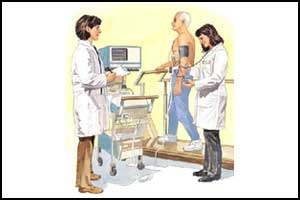- Home
- Editorial
- News
- Practice Guidelines
- Anesthesiology Guidelines
- Cancer Guidelines
- Cardiac Sciences Guidelines
- Critical Care Guidelines
- Dentistry Guidelines
- Dermatology Guidelines
- Diabetes and Endo Guidelines
- Diagnostics Guidelines
- ENT Guidelines
- Featured Practice Guidelines
- Gastroenterology Guidelines
- Geriatrics Guidelines
- Medicine Guidelines
- Nephrology Guidelines
- Neurosciences Guidelines
- Obs and Gynae Guidelines
- Ophthalmology Guidelines
- Orthopaedics Guidelines
- Paediatrics Guidelines
- Psychiatry Guidelines
- Pulmonology Guidelines
- Radiology Guidelines
- Surgery Guidelines
- Urology Guidelines
Head to Head-Stress Echo better than Coronary CTA for Chest Pain Triage

For patients presenting to the emergency department (ED) with chest pain, stress echocardiography (SE) can be considered an appropriate option for triaging over coronary computed tomography angiography (CTA), suggests a new study published in the journal JACC: Cardiovascular Imaging. The findings determined that the use of SE resulted in the hospitalization of a smaller proportion of patients with a shorter length of stay than coronary CTA and was safe.
Jeffrey M. Levsky, associate professor, radiology department, Montefiore Medical Center in New York, and colleagues to compare early ED use of coronary CTA and SE head-to-head.
Coronary CTA has been promoted as the early ED chest pain triage imaging method of choice, whereas SE is often overlooked in this setting and involves no ionizing radiation.
For the study, the authors randomized 400 consecutive low- to intermediate-risk ED acute chest pain patients without known coronary artery disease and a negative initial serum troponin level to immediate coronary CTA (n = 201) or SE (n = 199). The primary endpoint was hospitalization rate. Secondary endpoints were ED and hospital length of stay. Safety endpoints included cardiovascular events and radiation exposure.
Mean patient age was 55 years, with 43% women and predominantly ethnic minorities (46% Hispanics, 32% African Americans). Thirty-nine coronary CTA patients (19%) and 22 SE patients (11%) were hospitalized at presentation (difference 8%; 95% confidence interval: 1% to 15%; p = 0.026).
Key Results:
- Median ED length of stay for discharged patients was 5.4 h for coronary CTA and 4.7 h for SE.
- Median hospital length of stay was 58 h for coronary CTA and 34 h for SE.
- There were 11 and 7 major adverse cardiovascular events for coronary CTA and SE, respectively, over a median 24 months of follow-up.
- Median/mean complete initial work-up radiation exposure was 6.5/7.7 mSv for coronary CTA and 0/0.96 mSv for SE.
"The use of SE resulted in the hospitalization of a smaller proportion of patients with a shorter length of stay than coronary CTA and was safe. SE should be considered an appropriate option for ED chest pain triage," concluded the authors.
For further information log on to 10.1016/j.jcmg.2018.03.024

Disclaimer: This site is primarily intended for healthcare professionals. Any content/information on this website does not replace the advice of medical and/or health professionals and should not be construed as medical/diagnostic advice/endorsement or prescription. Use of this site is subject to our terms of use, privacy policy, advertisement policy. © 2020 Minerva Medical Treatment Pvt Ltd